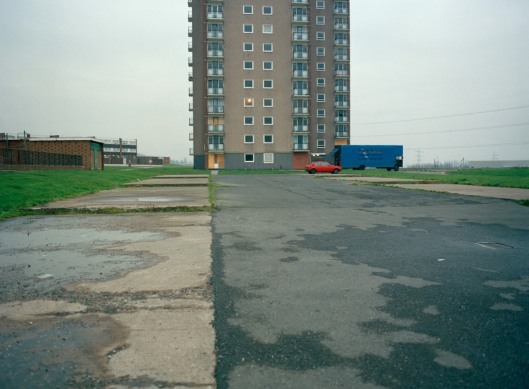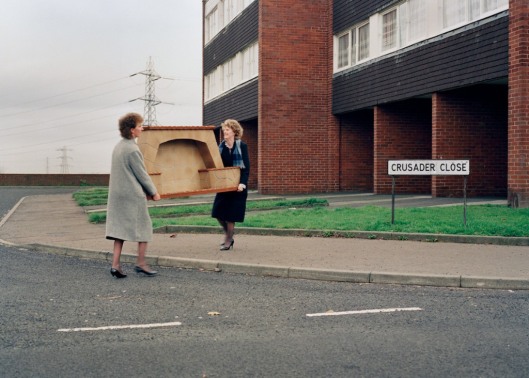I’m delighted to feature this guest post by Rob Clayton and some of his powerful and evocative photographs. I’ve seen Rob’s work for myself and the new film, based on his images, narrated by Jonathan Meades and highly recommend them. Full details are posted at the end of the post where you’ll also find further information on the project, current exhibitions and Rob’s book.
Shot over 25 years ago on the Lion Farm Estate, in Oldbury, in the West Midlands, Robert Clayton’s images capture life on a housing estate in the early 1990s. The work on display masterfully exhibits the real lives of those living there during this time coupled with an appreciation of the architecture which surrounds them.

Rooftop Study Three (c) Robert Clayton courtesy of LA Noble Gallery, London
My work is social documentary; drawn to the aesthetic of place, Lion Farm Estate (LFE) presented itself to me. With its sense of dystopian dislocation, I explored, seeking a reason for this other place on the hinterland of Britain’s second largest conurbation. This imposing, faded, typical manifestation, of the utopian post-war housing consensus offered a feast of visual opportunity in its powerful topography; the challenge was to go deeper to capture its daily life, its humanity.

House clearance (c) Robert Clayton courtesy of LA Noble Gallery, London
This was 1990 and I wanted to communicate the hidden – what life was like on an estate for many people at this time. Housing was an issue then and evidence, over twenty years later, suggests there is no solution to the housing crisis. But how can this be? What evidence is there?
My work captures the estate at the point of transition, and over time, has taken on a new life with age. It captures provision of housing on a large scale – evidence of a national duty to provide – yet hints at its imminent destruction. Lack of maintenance then condemnation was a precursor to change of ownership models – social anthropological evidence that leads us to ask, has the state abandoned its duty of care?

Moving, One (c) Robert Clayton courtesy of LA Noble Gallery, London
My photography attempts to get into the heart and fabric of 1990’s Britain, when the new order was well underway, promising ‘trickle down’ benefits for all. The broken promise remains and the evidence of failure mounts; 25 years on can we hold our breath any longer for the ‘market’ to provide? In my lifetime so far, we have moved from state mass provision to state-sanctioned asset stripping and housing, and by its very nature therefore the vast majority of us, are all victims in this new global order.

Resident discussing accommodation problem (c) Robert Clayton courtesy LA Noble Gallery, London
During the 1980s, British culture was changing: the collective, the ‘consensus’ was being abandoned in a shift towards the self. The images catch moments of dystopia as the utopian-inspired modernist landscape and all the hope it contained, fades. The images capture more than a topographical transformation; Lion Farm Estate is caught in a moment of multi-agency, politically-driven change. The images offer the topography with the humanity, the provision and the provided for. The loss of provision to follow.

Playground (c) Robert Clayton courtesy LA Noble Gallery, London
Housing today is far more a political issue than a pragmatic one. The images in LFE espouse a watershed in post-war Britain; the move from consensus, modernity to fragmentation, post-modernity. The grand post-war housing utopian ambitions of both the Left and Right were over. Social housing was to move to a new era of social engineering and become a battleground of fragmented political ideologies. A new political era had already been forged under Thatcher and ten years later the aim to house UK citizens was no longer a common political cause.

Hometime, teatime (c) Robert Clayton courtesy LA Noble Gallery
A new industry, the ‘Third Sector’ had been born, ‘Right to Buy’ was very popular and the social housing stock had been vastly diminished. Housing was sold at a fraction of its market value and gave the new owners a new land-owning status and wealth beyond their normal means and expectations. Property was effectively given away in pursuit of short-term political gain, under the guise of an unfulfilled human need to own land to satisfy a vested political interest.
LFE carefully exposes the visual fabric of this transition, yet the location and its inhabitants were more gentle and passive than the harsh environment may suggest. Despite the ever present influence of low income, lack of opportunity and their associated social problems, a strong sense of cohesiveness and belonging existed.

Crusader Close (c) Robert Clayton courtesy of LA Noble Gallery, London
This sense of community was threatened and struggled to retain its existence in the face of ‘beneficial redevelopment’. This is a cycle we know all too well today and one that dominates our urban transformations; perhaps the main difference being today that private developers’ interests trump all and the lack of political will to help the least empowered culminating in processes labelled ‘social cleansing’.

Shopping Five (c) Robert Clayton courtesy of LA Noble Gallery, London
A new era of ideology, a new industry employing a middle class of bureaucrats has grown in the last twenty-five years, supplying all sorts of exotic non-fixes to the housing issue: part-buy, part-rent, housing associations, incentive schemes, social housing quotas on private developments, help to buy…the list goes on.

Aeroplane Playground, Chiltern House (c) Robert Clayton courtesy of LA Noble Gallery, London
Nothing has solved the housing problems in the UK. The grand housing schemes of post-war Britain have alarmingly been consigned to the dustbin at a particular point in our history when a new central government-funded grand housing plan could provide many solutions to today’s economic woes. The commitment and ideological ambition to do this, however, is a distant dream; as distant as the rubble and memories of the tower blocks of the modern, utopian-conceived, spacious, light filled, plentiful and once cherished homes of the Lion Farm Estate.
Yet, is it a dream we have abandoned? Perhaps, like this body of work, it will materialize again.
There are current and forthcoming shows of Rob’s Lion Farm Estate images in London. Details as follows or click on the link:
- Until May 29 at the Four Corners Gallery, 121 Roman Road, London, E2 0QN, Tuesday to Saturday, 11.00-18.00
- From Friday 13 May to Sunday 22 May at FIX Photo 2016, The Barge House, OXO Tower, South Bank, London SE1 9PH, every day, 11.00-20.30 (Monday 16 to 19.00)
You can view the film of Rob’s images with commentary by Jonathan Meades at both shows and catch a preview here on YouTube.
You can buy the book at both shows. It is also available from online retailers or directly from Stay Free Publishing.
For more on Rob’s work, see his website, Lion Farm Estate. For prints, contact the LA Noble Gallery.

Winter sun (c) Robert Clayton courtesy of the LA Noble Gallery, London

Brilliant – thanks